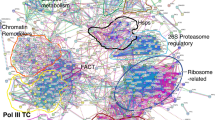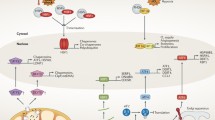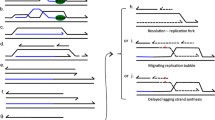Abstract
Regulation of stress response in prokaryotes is mainly achieved at the transcriptional initiation level. Prokaryotes use alternative holoenzymes, consisting of the core polymerase associated with different sigma factors, which confer on it altered specificity of transcriptional initiation. Stress response being probably one of the most inevitable features of life, it would be interesting to find if eukaryotes also use a similar strategy at this level of regulation. Since the yeastSaccharomyces cerevisiae is a model system for studying many different phenomena in eukaryotes we review the transcriptional regulation of stress in this system. Based on published observations in the literature and our own studies, we have analysed the regulation of stress response, in the yeastS. cerevisiae. Two of the core subunits of the yeast RNA polymerase II, which show altered stoichiometry within the polymerase under different conditions appear to be involved specifically in regulating the stress response. In a very broad sense then, the altered subunit composition of the core polymerase or a different holoenzyme, appears to correlate with gene expression specific to stress response inS. cerevisiae and probably reflects the scenario in other eukaryotes.
Similar content being viewed by others
References
Ashburner M and Bonner J J 1979 The induction of gene activity inDrosophila by heat shock;Cell 17 241–254
Choder M 1993 A growth rate limiting process in the last growth phase of the yeast life cycle involvesRPB4, a subunit of RNA polymerase II;J. Bacteriol. 175 6358–6363
Choder M and Young R A 1993 A portion of RNA polymerase II molecules have a component essential for stress response and survival;Mol. Cell. Biol. 13 6984–6991
Edwards A M, Kane C M, Young R A and Kornberg R D 1991 Two dissociable subunits of yeast RNA polymerase II stimulate the initiation of transcription at a promoterin vitro;J. Biol. Chem. 266 71–75
Gimeno C J and Fink G R 1994 Induction of the pseudohyphal growth by overexpression ofPHDI, aSaccharomyces cerevisiae gene related to transcriptional regulators of fungal development;Mol. Cell. Biol. 14 2100–2112
Goodrich J A, Cutler G and Tjian R 1996 Contacts in context: Promoter Specificity and Macromolecular Interactions in Transcription;Cell 84, 825–830
Gow N A R 1995 Yeast-hyphal dimorphism; inThe growing fungus (eds) N A R Gow and G M Gadd (London: Chapman and Hall) pp 403–422
Guarente L 1995 Transcriptional coactivators in yeast and beyond;Trends Biochem. Sci. 20 517–521
Khazak V, Sadhale P P, Woychik N A, Brent R and Golemis E A 1995 Human RNA polymerase II subunit hsRPB7 functions in yeast and influences stress survival;Mol. Biol. Cell. 6 759–775
Kerridge D 1993 Fungal dimorphism: A sideways look; inDimorphic fungi in biology and medicine (eds) H V Bosscheet al. (New York: Plenum Press) pp 3–10
Koleske A J and Young R A 1995 The RNA polymerase II holoenzyme and its implications for gene regulation;Trends Biochem. Sci. 20 113–116
Liu H, Kohler J and Fink G R 1994 Suppression of hyphal formation inCandida albicans by mutation ofSTE 12 homolog;Science 266 1723–1726
Mager W H and Ferreira P M 1993 Stress response of yeast;Biochem J. 290 1–13
Malathi K, Ganesan K and Datta A 1994 Identification of a putative transcription factor inCandida albicans that can complement the mating defect inSaccharomyces cerevisiae ste12 mutants;J. Biol. Chem. 269 22945–22951
McKune K, Richards K L, Edwards A M, Young R A and Woychik N 1993RPB7, one of two dissociable subunits of yeast RNA polymerase II is essential for cell viability;Yeast 9 295–299
Nakahigashi K, Kanemori M, Morita M, Yanagi H and Yura T 1998 Conserved function and regulation ofσ 32 homologues in Gram-negative bacteria;J. Biosci. 23 407–414
Nogi Y and Fukasawa T 1981 A novel mutation that affects utilization of galactose inSaccharomyces cerevisiae;Curr. Genet. 3 91–96
Nover L and Scharf K D 1997 Heat stress proteins and transcription factors;Cell. Mol. Life Sci. 53 80–103
Schumann W, Homuth G and Mogk A 1998 The GroE chaperonin machine is the major modulator of the CIRCE heat shock regulon ofBacillus subtilis;J. Biosci. 23 415–422
Shepherd M G, Poulter R T M and Sullivan P A 1985Candida albicans: Biology, Genetics and Pathogenicity;Annu. Rev. Microbiol. 39 579–614
Sorger P K and Pelham H R B 1988 Yeast heat shock factor is an essential DNA binding protein that exhibits temperature dependent phosphorylation;Cell 54 855–864
Struhl K 1995 Yeast transcriptional regulatory mechanisms;Annu. Rev. Genet. 29 651–674
Tissieres A, Mitchell H K and Tracey U M 1974 Protein synthesis in the salivary glands ofD. melanogaster. Relation to chromosome puffs;J. Mol. Biol. 84 389–398
Woychik N A and Young R A 1989 RNA polymerase II subunitRPB4 is essential for high and low temperature yeast cell growth;Mol. Cell. Biol. 9 2854–2859
Woychik N A and Young R A 1990 RNA polymerase II: subunit structure and function;Trends Biochem. Sci. 15 347–351
Young R A 1991 RNA polymerase II;Annu. Rev. Biochem. 60 689–715
Author information
Authors and Affiliations
Corresponding author
Rights and permissions
About this article
Cite this article
Sadhale, P., Sharma, N., Beena, P. et al. Modulation of polymerase II composition: A possible mode of transcriptional regulation of stress response in eukaryotes. J. Biosci. 23, 331–335 (1998). https://doi.org/10.1007/BF02936125
Published:
Issue Date:
DOI: https://doi.org/10.1007/BF02936125




